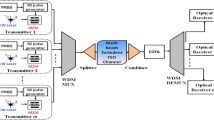Abstract
Free space optical communication (FSO) is thriving with greater pace nowadays due to its ability to support high speed, greater capacity, improved security, ease of installation, not having of Electromagnetic interference (EMI) and unlicensed spectrum. Atmospheric turbulence like Rain, Fog, and Haze is a prominent issue in FSO system that adversely affects the performance. This paper presents the demonstration of a multibeam FSO system operating at 1.25 Gbps in several haze types, including hazardous, very unhealthy, sensitive, good, moderate, and unhealthy. Additionally, BER and Q factor comparisons are made across three distinct pulse formats: carrier suppressed RZ (CSRZ), return to zero (RZ), and non-return to zero (NRZ). Utmost goal for the deployment of multibeam FSO is to get high received power and to compensate attenuation arising from haze effects. Results revealed that CSRZ performed exceptionally well as compared to NRZ and RZ.







Similar content being viewed by others
Data Availability
The authors confirm that the data used to support the findings of this study are available with in the manuscript and the Raw data that support the findings of this study are available from the corresponding author upon request.
References
Das, B., Mukherjee, S., Chattopadhyay, B., & Mazumdar, S. (2021). Design of a 10 GHz optical wireless communication link using low power C-band laser diode. Results in Optics, 5, 100129.
Salah, B., Kassa-Baghdouche, L., & Verma, A. (2019). SAC-OCDMA System with EDW codes over FSO under different conditions of Weather. IJRAR, 6(2), 749–755.
Kaur, S., Kaur, G., Singh, G., Verma, A., & Julka, N. (2017). Polarization crosstalk suppression in wavelength division multiplexed free space optical system incorporating polarization diversity. IJCRT, 5(3), 384–390.
Sheikh, S., Tripathi, A., & Verma, A. (2019). Performance analysis of high speed spectrum sliced FSO system. International Journal of Research in Engineering, Science and Management, 2(4), 381–384.
Kaur, S., Kumar, M., & Verma, A. (2019). A novel hybrid passive optical network, free space optical and visible light communication system. JETIR, 6(4), 258–261.
Kumar, A., Tripathi, A., & Verma, A. (2019). Mode division multiplexing in free space optical communication. International Journal of Research in Engineering, Science and Management, 2(4), 520–526.
Rathore, G., Madhu, C., & Dhindsa, A. (2018). Mitigation of Haze effects on free space optical communication using multibeam technique. Advances in Intelligent Systems and Computing, Springer, 989, 175–183.
Singh, M. (2017). “Enhanced performance analysis of inter-aircraft optical wireless communication link (IaOWC) using EDFA pre-amplifier. Wireless Personal Communications, 95, 1–11.
Sharma, V., & Kaur, G. (2013). High speed long reach OFDM-FSO transmission link incorporating OSSB and OTSB schemes. Optik, 124, 6111–6114.
Mohammad, A. B. (2014). Optimization of FSO system in tropical weather using multiple beams. In 2014 IEEE 5th International Conference on Photonics (ICP), Kuala Lumpur, Malaysia (pp. 109–112). https://doi.org/10.1109/ICP.2014.7002326
Raj, A. A. B., Krishnan, P., Darusalam, U., Kaddoum, G., Ghassemlooy, Z., Abadi, M. M., Majumdar, A. K., & Ijaz, M. (1922). A review-unguided optical communications: Developments, technology evolution, and challenges. Electronics, 2023, 12. https://doi.org/10.3390/electronics12081922
Mohammad, A. (2014). Optimization of FSO system in tropical weather using multiple beams. In IEEE 5th International Conference on Photonics (ICP) (pp. 109–12).
Al-Gailani, S. A., Shaddad, R. Q., Mohammad, A. B., Sheikh, U. U., & Elmagzoub, M. A. (2015). Hybrid WDM/multibeam free-space optics for multigigabit access network. Photonic Network Communications, 29, 138–145. https://doi.org/10.1007/s11107-014-0482-y
Grover, M., Preeti, S., & Kaur, P. (2017). Performance analysis of multibeam WDM-FSO system in clear and hazy weather conditions. In International Conference on Intelligent Communication, Control and Devices (pp. 189–95).
Grover, M., Singh, P., & Kaur, P. (2017). Mitigation of scintillation effects in WDM FSO system using multibeam technique. Journal of Telecommunications and Information Technology., 2, 69–74. https://doi.org/10.26636/jtit.2017.111917
Le, H. D., & Pham, A. T. (2022). Link-layer retransmission-based error-control protocols in FSO communications : A survey. IEEE Communications Surveys & Tutorials. https://doi.org/10.1109/COMST.2022.3175509
Satrusalya, S., & Goswami, L. (2023). Review on free space optical communication. Materials Today: Proceedings. https://doi.org/10.1016/j.matpr.2021.03.157
Funding
The authors declare that no funds, grants, or other support were received during the preparation of this manuscript.
Author information
Authors and Affiliations
Contributions
Study Conception and Design: SB, CM and ST. Material preparation, data collection and analysis: SB and CM. First draft of manuscript: SB. Approval to final manuscript: SB, CM, ST.
Corresponding author
Ethics declarations
Conflict of interest
The authors have no competing interests to declare that are relevant to the content of this article. The authors have no financial interest in any material discussed in this manuscript. The authors have no financial or non-financial interest in the subject matter or materials discussed in this manuscript. This manuscript is a part of research work performed. The authors declare that they have no conflicts of interest.
Human and Animal Rights
This article does not contain any study involving animals and human participants performed by any of the authors.
Additional information
Publisher's Note
Springer Nature remains neutral with regard to jurisdictional claims in published maps and institutional affiliations.
Rights and permissions
Springer Nature or its licensor (e.g. a society or other partner) holds exclusive rights to this article under a publishing agreement with the author(s) or other rightsholder(s); author self-archiving of the accepted manuscript version of this article is solely governed by the terms of such publishing agreement and applicable law.
About this article
Cite this article
Bagga, S., Madhu, C. & Thangjam, S. Enhanced Performance Analysis of Multibeam FSO by Incorporating Carrier Supressed Return to Zero (CSRZ). Wireless Pers Commun 133, 2427–2437 (2023). https://doi.org/10.1007/s11277-024-10879-w
Accepted:
Published:
Issue Date:
DOI: https://doi.org/10.1007/s11277-024-10879-w




